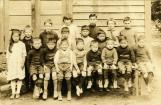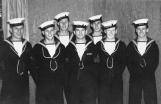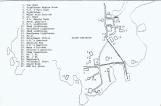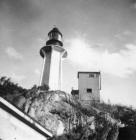1
War at the LighthouseThe Japanese attack on a United States military base in Pearl Harbour in Hawai'i in 1941 and an attack on the lighthouse at Estevan on Vancouver Island attributed to a Japanese submarine led to increased concerns for the security of the west coast of North America. The attacks stirred up fear and racism that forced the relocation of nearly 23,000 Japanese Canadians living on the coast to detention camps in the interior of British Columbia and east of the Rocky Mountains.
2
Original Cypress Park School, c. 1923. Larry Grafton, back row, second from right.1923
West Vancouver, British Columbia, Canada

3
At the same time that the federal government mobilized to contain what they believed were a fifth column of Japanese Canadians, Canada decided that the Vancouver harbour should prepare to defend against possible Japanese military attack. As a result, Point Atkinson was an active part of the coastal defence system for the port of Vancouver.4
Point Atkinson was manned by the 31st Coast Battery of the 15th (Vancouver) Coast Regiment Royal Canadian Artillery and the 3rd Searchlight Battery of the 1 Searchlight Regiment Royal Canadian Artillery. The Port War Signal Station, built adjacent to the west side of the tower, was run by the Navy and was responsible for controlling all water traffic in and out of the port. An imaginary examination line ran across the harbour from Point Atkinson to Point Grey. Ships entering the harbour were to identify themselves to one of two naval examination vessels patrolling the area. Ships that failed to do so had a warning shot fired across their bow by an eighteen pounder gun located on the shore in front of the lighthouse. Two searchlight bunkers, located on either side (east and west) of the lighthouse, were used to identify vessels at night. A military camp housing up to eighty men was located directly behind the lighthouse in the forest. The camp provided accommodation for the artillery and other service personnel and consisted of eight buildings: an officer's mess, kitchen, guard house, ablution hut, and sleeping barracks.5
Vetrans' Home Guard and Navy Signalmen.1940
Point Atkinson, West Vancouver, British Columbia, Canada
 Credits:
Credits:Courtesy of Norm Dawe.
6
Navy signalmen.1940
Point Atkinson, West Vancouver, British Columbia, Canada
 Credits:
Credits:Courtesy of Norm Dawe.
7
Veteran's Home Guard members on steps with dog.1939
Point Atkinson, West Vancouver, British Columbia, Canada
 Credits:
Credits:Courtesy of Norm Dawe.
8
Soldier.1940
Point Atkinson, West Vancouver, British Columbia, Canada
 Credits:
Credits:Courtesy of Ernie Toews.
9
Searchlights and cannon were installed at Point Atkinson, Stanley Park, Narrows North and Point Grey…. An imaginary examination line stretched across the harbour from the lighthouse to Point Grey on the south shore, like a bit in the harbour's mouth. Any ships entering the harbour were to identify themselves to one of the two naval patrol vessels patrolling just outside. If they failed or forgot, gunners fired a round across their bow; if the ship continued, the gunners would sink them.- From Don Graham, Keepers of the Light, 1985, p. 75.
10
Map of Vancouver's Coastal Defenses.1942
Point Atkinson, West Vancouver, British Columbia, Canada

11
Eighty [conscripts] were billeted in new cedar barracks hastily thrown up in the forest behind the Point Atkinson Station. Labourers constructed a huge concrete bunker with sliding steel doors for a searchlight, and bolted a Mark I eighteen-pound cannon onto a pivot supported by a concrete base in front of the radio room.- From Don Graham, Keepers of the Light, 1985, p. 74.
12
Map of buildings.1942
Point Atkinson, West Vancouver, British Columbia, Canada
 Credits:
Credits:Courtesy of the 15th Field Regiment Museum.
14
Navy signal house next to lighthouse, from lower rocks.1942
Point Atkinson, West Vancouver, British Columbia, Canada
 Credits:
Credits:Courtesy of Norm Dawe.
